Service Provider Routing and Switching Specialist (JNCIS-SP)
Here you have the best Juniper JN0-361 practice exam questions
- You have 36 total questions to study from
- Each page has 5 questions, making a total of 8 pages
- You can navigate through the pages using the buttons at the bottom
- This questions were last updated on March 30, 2025
